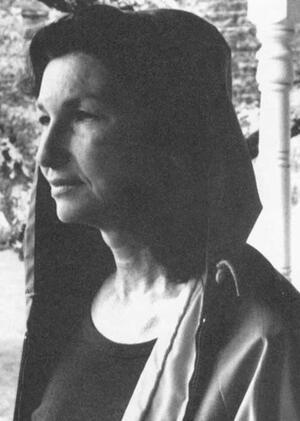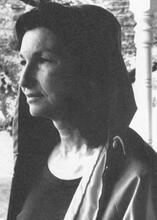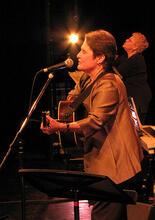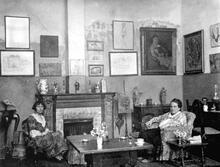Esther M. Broner
With her novels Journal/Nocturnal (1968) and A Weave of Women (1978), Esther M. Broner emerged on the literary scene as a leading feminist writer with bitter, fearless, and funny characters. In 1982 she moved to New York City, where she joined and help to shape a thriving community of Jewish feminists. In 1976 she published a “Women’s Haggadah” in Ms. Magazine. Her engagements with Jewish tradition through the creation of new rituals propelled Broner’s writing in an autobiographical direction. In two books related to her parents’ deaths, she continued to combine autobiography and acute feminist critique of Jewish ritual. Broner was also a playwright and she published short stories in numerous periodicals. She also spent time teaching at various universities across the United States and Israel.
Education & Family
Novelist, playwright, ritualist, and feminist writer, Esther M. Broner was born on July 8, 1927, in Detroit, Michigan, the daughter of Paul Masserman, a journalist and Jewish historian, and Beatrice (Weckstein) Masserman, once an actor in Yiddish theater in Poland. Educated at Wayne State University, where she received her B.A. and M.A, and later served as a professor of English and writer-in-residence, she completed her Ph.D. at Union Graduate School in 1979.
Before she was twenty years old, she married artist Robert Broner. The couple had four children, two of whom were twins. Before any of the children turned five years old, Esther Broner had written autobiographically about the passions of everyday life and about her Jewish heritage.
Emergence as a Feminist Writer
Beginning with her 1968 experimental novel Journal/Nocturnal, Broner articulated forceful and original views about the experiences of women. With the publication of Her Mothers in 1975, Broner emerged as a leading feminist writer whose characters were bitter, fearless, and uproariously funny. “It’s a gentle book and yet a savage one,” one reviewer wrote, about the birth, nurturance, and rebirth of all women. Her novel A Weave of Women (1978) combined Jewish and feminist themes to achieve a mystical, surreal, and hilarious vision of women who invent a new society. This pair established Broner as a writer of enduring masterpieces that expressed but were not contained by the feminist movement.
Marking her presence in the academic world, she edited with Cathy Davidson a collection of scholarly articles, The Lost Tradition: Mothers and Daughters in Literature (1981). Broner and Davidson began their collaboration in 1975 at the Midwest Modern Language Association meeting when members of the women’s caucus voted to hold a special workshop on mothers and daughters in literature at their next convention.
Engagement with Jewish Tradition
In 1982, Esther and Robert Broner moved to New York City. There she joined and helped shape a thriving community of Jewish feminists, becoming a ritualist who invented new rites of passage to mark the new era. In the spring of 1976 Broner published “Women’s Haggadah” in Ms. magazine. Published as a book in 1994, this more direct engagement with Jewish tradition carried her writing into a more explicitly autobiographical direction. Her memoir The Telling: The Story of a Group of Jewish Women Who Journey to Spirituality Through Community and Ceremony (1993) gives a historical overview of her previous ten years and provides an instructional guide to Jewish feminism.
In two books that described her reaction to first her father’s and then her mother’s deaths, Broner continued this combination of compelling autobiography and acute feminist critique of Jewish ritual. Mornings and Mourning: A Lit. (Aramaic) "holy." Doxology, mostly in Aramaic, recited at the close of sections of the prayer service. The mourner's Kaddish is recited at prescribed times by one who has lost an immediate family member. The prayer traditionally requires the presence of ten adult males.Kaddish Journal (1994) narrates her day-to-day struggle to join a local The quorum, traditionally of ten adult males over the age of thirteen, required for public synagogue service and several other religious ceremonies.minyan in the year following her father’s death. Ghost Stories (1995) tenderly relates and gives meaning to her mother’s death. Both works draw on Broner’s capacity for self-transcendence through wildly improbable humor and deeply committed spirituality.
Other Publications & Teaching Career
Broner’s work as a dramatist began early in her career with Colonel Higginson(1968) and The Body Parts of Margaret Fuller (1976), which draws on her interest in American literary history. In 1982 she adapted A Weave of Womento the stage and she later completed Letters to My Television Past (1985), The Olympics (1986), and Half-a-Man (1989), which were staged in New York City, Los Angeles, and Detroit. Her short stories have appeared in dozens of periodicals.
In addition to Wayne State University, she taught at the University of California, Los Angeles; the University of Haifa, Israel; Hebrew University, Jerusalem; Oberlin College; and Sarah Lawrence College.
Broner passed away on June 21, 2011, at the age of 83.
Selected Works
Journal/Nocturnal 1968. New York: Harcourt, Brace & World, 1968
Her Mothers. Bloomington, Indiana: Indiana University Press, 1975
A Weave of Women. New York: Holt, Rinehart & Winston, 1978
Edited by Esther M. Broner and Cathy N. Davidson. The Lost Tradition: Mothers and Daughters in Literature. New York: F. Ungar Pub. Co., 1980.
The Telling: The Story of a Group of Jewish Women Who Journey to Spirituality Through Community and Ceremony. New York: HarperSanFrancisco 1993.
Mornings and Mourning: A Kaddish Journal. New York: HarperSanFrancisco 1993
Ghost Stories. New York: Global city Press, 1995
Gerstle, Ellen. “The Bible as Feminist Discourse: Broner’s ‘A Weave of Women.’” Studies in American Jewish Literature (1981-) 18, The Ties that Bind: After Twenty Five Years, A Look Back and Ahead (1999): 78-82
Omer, Ranen. “’O, My Shehena, Who Shall Live in Your Tent?’: Gender, Diaspora, and the Ambivalence of Return in E. M. Broner’s ‘A Weave of Women.’” Frontiers: A Journal of Women Studies 23, no. 1 (2002): 96-125
Shapiro, Ann R. “The Novels of E. M. Broner: A Study in Secular Feminism and Feminist Judaism.” Studies in American Jewish Literature (1981-) 10, no. 1 (Spring 1991): 93-103






